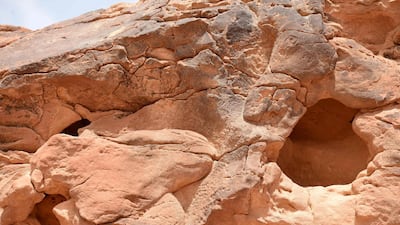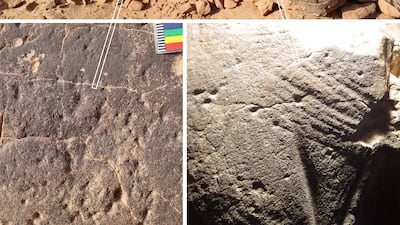Stunning relief carvings of camels in Saudi Arabia are now thought to date back more than 7,000 years – making them more than three times as old as was first suggested.
Previously, it was thought the ancient camel sculptures found in the northern province of Al Jouf were about 2,000 years old.
However, chemical analysis and the examination of tool marks helped to show that the carvings at the site were made in the sixth millennium BCE.
It means the remarkable life-size sandstone carvings of camels and other animals, including a donkey, are the world’s oldest surviving large-scale reliefs.
One of the functions of rock art sites ... is a way to mark space; this is the place we come to meet
Dr Maria Guagnin,
Max Planck Institute for the Science of Human History
“They are absolutely stunning and, bearing in mind we see them now in a heavily eroded state with many panels fallen, the original site must’ve been absolutely mind blowing,” said Dr Maria Guagnin, from the department of archaeology at Germany’s Max Planck Institute for the Science of Human History, the lead author of a new study on the late Stone Age carvings.
“There were life-sized camels and equids two or three layers on top of each other. It must have been an absolutely stunning site in the Neolithic."
Researchers heard about the site about five years ago and before the coronavirus pandemic, Dr Guagnin and other specialists made two visits of about 10 days each to examine the carvings.
The presence of camel reliefs at Petra in Jordan, produced by Nabataeans about 2,000 years ago, had suggested the Saudi carvings may be about two millennia old.
However, a stone mason analysing the camel site carvings did not find evidence that metal tools had been used and there was no sign of pottery.
Weathering and erosion patterns, high-tech analysis involving fluorescence and luminescence and radiocarbon dating of remains also indicated an early origin.
"Every day the Neolithic was more likely [as the time when the carvings were made] until we realised it was absolutely a Neolithic site we were looking at,” Dr Guagnin said.
Researchers also came from the Saudi Ministry of Culture, King Saud University and France’s Centre National de la Recherche Scientifique.
Story behind the carvings
On three rock spurs there are 21 carvings, each thought to have taken about 10 to 15 days to complete, during which time the stone tools used would have been resharpened and replaced frequently.
The tools were made from a rock called chert, which came from at least 15 kilometres away, and a platform or rigging would have been needed to hold whoever was carrying out the carving.
The Max Planck Institute saidthe carvings were probably produced as part of a communal effort, perhaps involving an annual gathering.
“The weight gain and references to the mating season in the camel reliefs suggests that they may be symbolically connected to the yearly cycle of wet and dry seasons to which these biological changes are linked,” the organisation said.
Most or all were carved by the late sixth millennium BC, but reconstructions of carving and weathering indicate that the site was used for generations and the panels re-engraved and re-shaped.
When the carvings were made, the area was mostly grassland with some lakes and trees where, as well as keeping herds of domestic animals, local people hunted wild camels and equids.
What exactly the site was used for, such as whether it was a place of worship, is unlikely to ever be known.
“Were they lighting fires underneath or feasting near them or just looking at them? One of the functions of rock art sites in general is not just in actual symbolism and belief that might be linked to the imagery. It’s a way to mark space; this is the place we come to meet,” Dr Guagnin said.
Attention now turns to preserving the site in the face of wind and moisture, and further studies of the sandstone are needed to determine what measures will be most suitable.
Researchers are also interested in whether there are other similar sites.
They have generated three-dimensional models of the site and these could be used to produce digital interactive models for the public.
With Saudi Arabia having begun to issue tourist visas in 2019, the camel site could become a major draw.
“The site itself is quite spectacular, seeing them in place,” Dr Guagnin said. “If I was a tourist, I would want to go and see it.”
Last 10 NBA champions
2017: Golden State bt Cleveland 4-1
2016: Cleveland bt Golden State 4-3
2015: Golden State bt Cleveland 4-2
2014: San Antonio bt Miami 4-1
2013: Miami bt San Antonio 4-3
2012: Miami bt Oklahoma City 4-1
2011: Dallas bt Miami 4-2
2010: Los Angeles Lakers bt Boston 4-3
2009: Los Angeles Lakers bt Orlando 4-1
2008: Boston bt Los Angeles Lakers 4-2
The more serious side of specialty coffee
While the taste of beans and freshness of roast is paramount to the specialty coffee scene, so is sustainability and workers’ rights.
The bulk of genuine specialty coffee companies aim to improve on these elements in every stage of production via direct relationships with farmers. For instance, Mokha 1450 on Al Wasl Road strives to work predominantly with women-owned and -operated coffee organisations, including female farmers in the Sabree mountains of Yemen.
Because, as the boutique’s owner, Garfield Kerr, points out: “women represent over 90 per cent of the coffee value chain, but are woefully underrepresented in less than 10 per cent of ownership and management throughout the global coffee industry.”
One of the UAE’s largest suppliers of green (meaning not-yet-roasted) beans, Raw Coffee, is a founding member of the Partnership of Gender Equity, which aims to empower female coffee farmers and harvesters.
Also, globally, many companies have found the perfect way to recycle old coffee grounds: they create the perfect fertile soil in which to grow mushrooms.
How to report a beggar
Abu Dhabi – Call 999 or 8002626 (Aman Service)
Dubai – Call 800243
Sharjah – Call 065632222
Ras Al Khaimah - Call 072053372
Ajman – Call 067401616
Umm Al Quwain – Call 999
Fujairah - Call 092051100 or 092224411
UAE currency: the story behind the money in your pockets
The President's Cake
Director: Hasan Hadi
Starring: Baneen Ahmad Nayyef, Waheed Thabet Khreibat, Sajad Mohamad Qasem
Rating: 4/5
The five pillars of Islam
About Karol Nawrocki
• Supports military aid for Ukraine, unlike other eurosceptic leaders, but he will oppose its membership in western alliances.
• A nationalist, his campaign slogan was Poland First. "Let's help others, but let's take care of our own citizens first," he said on social media in April.
• Cultivates tough-guy image, posting videos of himself at shooting ranges and in boxing rings.
• Met Donald Trump at the White House and received his backing.
Company Profile:
Name: The Protein Bakeshop
Date of start: 2013
Founders: Rashi Chowdhary and Saad Umerani
Based: Dubai
Size, number of employees: 12
Funding/investors: $400,000 (2018)
UAE currency: the story behind the money in your pockets
Read more about the coronavirus
Key facilities
- Olympic-size swimming pool with a split bulkhead for multi-use configurations, including water polo and 50m/25m training lanes
- Premier League-standard football pitch
- 400m Olympic running track
- NBA-spec basketball court with auditorium
- 600-seat auditorium
- Spaces for historical and cultural exploration
- An elevated football field that doubles as a helipad
- Specialist robotics and science laboratories
- AR and VR-enabled learning centres
- Disruption Lab and Research Centre for developing entrepreneurial skills
Timeline
2012-2015
The company offers payments/bribes to win key contracts in the Middle East
May 2017
The UK SFO officially opens investigation into Petrofac’s use of agents, corruption, and potential bribery to secure contracts
September 2021
Petrofac pleads guilty to seven counts of failing to prevent bribery under the UK Bribery Act
October 2021
Court fines Petrofac £77 million for bribery. Former executive receives a two-year suspended sentence
December 2024
Petrofac enters into comprehensive restructuring to strengthen the financial position of the group
May 2025
The High Court of England and Wales approves the company’s restructuring plan
July 2025
The Court of Appeal issues a judgment challenging parts of the restructuring plan
August 2025
Petrofac issues a business update to execute the restructuring and confirms it will appeal the Court of Appeal decision
October 2025
Petrofac loses a major TenneT offshore wind contract worth €13 billion. Holding company files for administration in the UK. Petrofac delisted from the London Stock Exchange
November 2025
180 Petrofac employees laid off in the UAE






